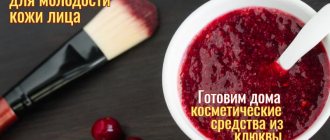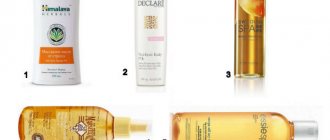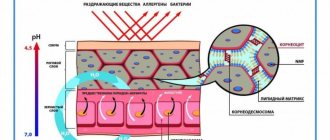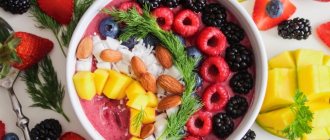How does oxidative (or oxidative) stress affect the skin?
When, under the influence of negative external and internal factors, the balance of the oxidative and reductive systems is disturbed towards oxidation, a large number of radicals are formed in the skin, participating in lipid peroxidation. This leads to damage to nucleic acids, cellular proteins and lipids. Such processes have an extremely negative effect on the condition of the epidermis and its functions. Ceramides are damaged - lipid molecules, which are the main building component of the outer layers of the skin, forming a lipid barrier (protecting the skin from dehydration, peeling, irritation, penetration of foreign substances, etc.).
By oxidizing lipids, free radicals provoke a lack of moisture, inflammatory reactions, and the risk of developing bacterial infections and pollution. As a result, damage to the cell membranes of the epidermis and dermis may occur, which will weaken the protective function of the skin and may cause the formation of various cosmetic defects. Proteoglycans and hyaluronic acid are destroyed (which accelerates skin aging).
In addition, free radicals destroy the skin framework, damaging collagen and elastin fibers and preventing their synthesis. (Oxidized collagen molecules become free radicals and bind to each other, forming dimers: the so-called “cross-linked” collagen is formed, less elastic and resistant to the action of enzymes.) As a result, the firmness and elasticity of the skin suffers, wrinkles are easily formed, and tissue ptosis appears.
To prevent (or promptly eliminate) such consequences, doctors recommend maintaining a healthy lifestyle: this includes physical exercise, healthy sleep, avoiding stressful situations, limiting alcohol and quitting smoking, protection from excessive ultraviolet radiation (it is recommended to use products with SPF during the active sun season -protection). In addition, it is important to monitor your diet: it must be properly balanced.
Nina Vitalievna Levushkina, brand technologist at PLEYANA:
“A well-balanced diet will contain adequate amounts of vegetables and fruits. It is recommended to include sea fish and cold-pressed vegetable oils. All this is necessary to replenish the supply of vitamins E, C, A, F, bioflavonoids, coenzyme Q10 and other antioxidants important for the body.”
Also, to protect and restore healthy skin functions, today there is a wide range of cosmetics containing various types of antioxidants.
Antioxidants - what are they?
Antioxidants (“antioxidants”) are compounds that can slow down oxidative processes in the body. Their action is very important for maintaining youth and health of the entire body and skin in particular.
Oxidative processes in the body occur constantly (this mechanism is called “lipid peroxidation”). These chemical reactions are necessary. Thanks to them, programmed cell death occurs and bioregulators are synthesized.
The products of oxidative processes are reactive oxygen species (free radicals and peroxides).
Free radicals are molecules that have a vacant electron spot, which they try to fill by stealing the missing electron from other molecules. If this succeeds, the injured molecule itself becomes a free radical. This develops a chain reaction of avalanche-like formation of free radicals, which is called oxidative stress.
Excess free radicals are dangerous for the body because they have a damaging effect on cell membranes. A damaged cell is no longer able to fully perform its functions and often dies. This mechanism explains the aging of the skin and the entire body.
In addition, the theory of oxidative stress explains the development of many diseases of modern man, such as cardiovascular and cancer diseases, infertility, Parkinson's disease, Alzheimer's disease, etc.
To protect against free radicals, the body has an antioxidant defense system. Antioxidant molecules are capable of reducing oxidized compounds and blocking oxidation reactions.
Only balance within the “lipid peroxidation – antioxidant defense system” system can ensure the biological safety of the body and prevent early aging.
Antioxidants: protecting cells from destruction
The human body is equipped with a multi-level system of protection against the destructive effects of harmful radicals. It is called the antioxidant system, or AOS. The components of this body's defense system are called antioxidants.
Antioxidants are natural or synthetic substances that can slow down or stop the oxidation process of organic compounds. At their core, antioxidants are also radicals (particles with a missing or extra electron) that are ready to react with “harmful” radicals in order to break (or slow down) the oxidation chain.
The mechanism of action of the main part of antioxidants is as follows: antioxidant molecules interact with active radicals (which leads to the formation of low-active radicals) or destroy intermediate reaction products (as a result of which oxidation slows down, as the rate of formation of free radicals decreases). So, the main task of antioxidants is to break branched chain oxidation.
This is done in two ways. In the first, an antioxidant molecule containing a mobile hydrogen atom interacts with an active particle - a radical leading the oxidative chain - and oxidizes it, resulting in the formation of a low-active radical. Derivatives of secondary aromatic amines and phenols work according to this principle. In the second method, the antioxidant molecule reacts with the intermediate oxidation product, which leads to its decomposition and chain branching, thereby forming a stable compound. This is how organic derivatives of phosphites and sulfides act.
There are three main levels of antioxidant protection in the body: anti-oxygen (prevents “electron leakage” in mitochondria), anti-radical (prevents the formation of radicals) and anti-peroxide (protects cell membranes and enzyme systems of the cell).
A whole complex of enzymes is involved in the work of AOS, among which superoxide dismutase, catalase, peroxidase, and various reductases (glutathione reductase, methionine sulfoxide reductase, diascorbate reductase, etc.) are especially well known. In addition to enzymes, AOS also includes a number of cell metabolites: lipoic, ascorbic and uric acids, the tocopherol family, about 500 carotenoid compounds, flavonoids, polyphenols (4000–5000 compounds), urates and others. Also directly related to the protective system are: the amino acid taurine, the dipeptide carnosine, the catabolism product of heme-containing proteins - bilirubin, melatonin (a multifunctional antioxidant, one of the pineal gland hormones). Often, individual components of AOS work in synergy, enhancing each other’s actions (the process of studying this kind of interaction continues).
The discovery of antioxidants and their first use were associated with an attempt to preserve food for a longer period of time. After the war, the food problem was acute in the Soviet Union: scientists had to solve the pressing issue of extending the service life of products in order to avoid their spoilage. Research by B.N. Tarusov in the 1950s showed that changes in the surface properties of butter are the result of lipid peroxidation. Then vitamins (including E and C) began to be added to products to protect against oxidation. In 1961, biophysicist A.I. Zhuravlev discovered antioxidant activity in living organisms.
There is no uniform classification of antioxidants. However, they are usually divided:
- by molecular structure: they distinguish enzymes (superoxide dismutase, catalase, peroxidase, phospholipase, etc.) and organic compounds with non-enzymatic activity, which are macromolecular (melatonin, transferrin, cerruloplasmin, ferritin, serum albumin) and low molecular (ascorbic acid, glutathione, urea, bilirubin, sulfur-containing amino acids, adrenaline, steroid hormones, some vitamins, ubiquinone, flavonoids, some types of trace elements);
- according to the ability to act in the aqueous or lipid phase: polar (water-soluble) and non-polar (fat-soluble);
- by localization of action in cellular structures: membrane, intracellular and extracellular.
Antioxidants also differ in their mechanism of action:
- “scavengers” - react with all free radicals and neutralize them, restoring them to stable forms;
- “traps” - have an affinity for certain substances with which they react;
- “antioxidants that break biochemical chains” are substances that are even more active than free radicals: by reacting with the latter, these antioxidants make the radicals weakly active.
According to the classification of antioxidants according to A.V. Kudrin and O.A. Gromova (Russian scientists who have published a number of works on the role of microelements in medicine), they can be endogenous (originally present in the body) and exogenous (coming from the outside).
The first include:
- enzymes: superoxide dismutase (SOD) – zinc-, copper- and manganese-dependent, glutathione peroxidase, glutathione-S-transferase, etc.;
- metabolites: glutathione-GSH (oxidized and reduced), glutathione cell cycle, ubiquinone Q10.
The second ones include:
- vitamins and provitamins: alpha-, beta-, gamma-carotenes, vitamin A, retinoids, alpha-tocopherol (vitamin E), phylloquinone (vitamin K), vitamin C, rutin;
- plant substances: ubiquinone (coenzyme Q10), quercetin, polyphenolic compounds, catechins, chlorophylls, pigment complexes, glycosides, essential oils, bioflavonoids, gallic acids, thiol compounds;
- antioxidant cofactors: riboflavin, vitamin B6, pantothenic acid, omega-3, omega-6;
- trace elements: selenium, zinc, cobalt, manganese;
- medications.
We can conditionally distinguish three levels of antioxidant protection of the skin: surface (membrane or barrier protection), extracellular and intracellular.
Surface protection is located in the upper layers of the skin and is the first stage of protection against harmful factors (mainly acting from the outside). These include large amounts of fat-soluble beta-carotene, alpha-tocopherol and squalene.
Extracellular – implies protection mainly of the intercellular space from damage. It includes: alpha-tocopherol, vitamin C, glutathione, superoxide dismutase, glutathione peroxidase (containing selenium), catalase.
Intracellular protection contains all types of antioxidants. It is carried out due to fat-soluble antioxidants located in the cell membrane (structural component - lipids) and water-soluble antioxidants (located in the cell membrane and membranes of its organelles in those areas where free radicals are formed and where they come into contact with the cell (outer cell membrane). One of the water-soluble antioxidants in this protection is tripeptide glutathione (its concentration here is much higher than other antioxidants).
At the moment, many antioxidants are known, differing in their strength, mechanism of action and specificity - some of them are fat-soluble, some are water-soluble, and this fact determines which free radicals each of them will neutralize. The human body synthesizes most of the antioxidants on its own, but some of them, for example, vitamin C, flavonoids, selenium, must be obtained through food.
Antioxidants in cosmetics
With age, the smooth functioning of the antioxidant system gradually deteriorates; in addition, there are many other unfavorable factors that influence the excessive production of ROS, including UV radiation, ionizing radiation, psycho-emotional stress, environmental pollution, poor and excessive nutrition, alcohol consumption, and smoking. In order to balance oxidative stress, as well as strengthen antioxidant protection in case of aging of the body, antioxidants (AO) come to the rescue - natural or synthetic substances that slow down oxidation and the development of radical chain reactions. When added to a cosmetic product, antioxidants perform two functions at once: firstly, they work as preservatives, protecting the product from spoilage, and secondly, they resist oxidative stress in the skin, have an immunomodulatory, anti-inflammatory and photoprotective effect. It is important that the product contains several antioxidants at once, both water- and fat-soluble, capable of working in different directions, as well as restoring each other’s activity. One of the effective ways to combine two types of AO and ensure their deep delivery is liposomal technology, where aqueous components are in water, and fatty components are immersed in a lipid membrane. Fat-soluble antioxidants include: vitamin E, coenzyme Q10, carotenoids (beta-carotene, lutein, lycopene), a form of vitamin C - ascorbyl palmitate. Water-soluble antioxidants are represented by ascorbic acid and its derivatives, plant polyphenols, sulfur-containing compounds (glutathione, cysteine, methionine), cinamic acids (coumaric, ferulic, caffeic). The best antioxidant combinations are found in plants - where nature itself has calculated various mixes to support plant life even in harsh living conditions, protecting them from aggressive sunlight, insects, fungi and other diseases. Vegetable oils are rich in vitamin E esters, carotenoids and terpenes - essential oils, and their aqueous extracts are rich in various polyphenols. Polyphenols are a large group of plant antioxidants, including such diverse compounds as flavonoids (these can be anthocyanidins - blueberries, grapes, isoflavonoids - ginko and soybeans, flavanols, flavones - quercetin), stilbenes (the most famous resveratrol) - interrupt the reactions of lipid peroxidation, lignans – algae, cereals, flax seeds, phenols – blueberries, coffee, cinnamon, kiwi, tea. Let's consider the most famous and well-studied antioxidants that can be found in cosmetics: Vitamin E - vitamin E esters prevent lipid peroxidation, protect cell membranes and the lipid barrier of the skin, and reduce UV-induced skin inflammation. Rich plant sources of vitamin E are rosehip, borage, amaranth, almond, apricot kernel oils, and wheat bran oil extract. Vitamin C is a major water-soluble antioxidant that can also reduce pigmentation and increase collagen production, improving skin firmness. Beta carotene is a precursor of vitamin A, gives plants an orange tint - for example, carrots, yams, pumpkin, and sea buckthorn are rich in it. Beta carotene neutralizes singlet oxygen, the first free radical that appears in the skin when exposed to UV radiation. Alpha lipoic acid is a powerful natural fat-soluble antioxidant that can fight ROS, slow down the aging of mitochondria, and restore vitamins C and E. Coenzyme Q10 is a fat-soluble coenzyme present in the membranes of all cells, especially in mitochondria - where it is necessary for the reaction to occur during which ATP is formed - the universal energy of the cell. As an antioxidant, coenzyme Q10 directly intercepts free radicals, reduces cell damage caused by UV radiation, and restores vitamin E. Idebenone is a synthetic analogue of coenzyme Q10, which is better soluble in water, but at the same time works a little weaker, but it works very well in sun protection cosmetics. Superoxide dismutase is an enzyme that protects almost all cells in the body from oxidative stress and damage caused by UV radiation. Interestingly, this enzyme remains active even after donating its electron. Glutathione is a peptide consisting of three amino acids and has a powerful antioxidant and whitening effect. It performs its functions well when paired with vitamin C. Ergothioneine , an amino acid obtained from mushrooms and animal tissues, belongs to the new generation of antioxidants. Effectively protects against lipid peroxidation. Ferulic acid – neutralizes nitric oxide and other free radicals, prevents cell damage from UV exposure, and lightens hyperpigmentation. Resveratrol is a substance from the group of polyphenols, derived from dark grape varieties and grape seeds. It works as an AO and also activates the SIRT1 gene, which encodes the sirtuin protein, which can prolong cell life. Melatonin is a fat-soluble hormone produced in the pineal gland of the brain, in addition to its vital functions in controlling circadian rhythms, it has a strong antioxidant effect. Green tea extract is rich in various polyphenals: catechin, quercetin, vitamins C and E. This combination of biologically active substances protects membranes and DNA well from damage. Turmeric extract contains many polyphenols that have antioxidant, anti-inflammatory and even antitumor effects. Edelweiss extract and edelweiss stem cell extract - due to the high content of amino acids, vitamins, polyphenols and tannins, edelweiss extract has strong antioxidant activity and also has a positive effect on skin hydration and elasticity.
How many antioxidants do you need?
Based on the fact that our body has its own antioxidant system, which normally maintains its functions at a high level, successfully protecting cells from oxidative stress, a logical continuation of this idea would be the use of topical and oral (in the form of dietary supplements) antioxidants when this becomes really necessary. Limited and targeted use of antioxidants allows you to solve two problems at once: firstly, it does not “relax” your own antioxidant system, giving it a chance to work at full strength, and secondly, it does not allow excess antioxidants to turn into their opposite - pro-oxidants, which are harmful to humans . And although debate about the need to use antioxidants is still ongoing in the scientific community, the most reliable and safe cosmetic directions with antioxidants are usually called: Day and sunscreens In day and SPF creams, antioxidants act as a protective shield, helping to reduce skin damage caused by the sun's rays and external pollutants. In addition, many antioxidants increase the effectiveness and stability of sunscreen filters. It is best to apply such cosmetics in the morning before going outside, and also, if desired, immediately after returning - to prevent UV damage to the skin. Cosmetics with a rejuvenating effect on the skin In addition to components that maintain elasticity and moisture are good, combinations of various antioxidants can be added to the cream formulation, which can also affect collagen synthesis, skin lightening and strengthening of the vascular wall. These AOs include: grape seed extract, green tea, edelweiss, licorice, shiitake, superoxide dismutase. Treatments for Damaged Skin After exfoliation and other physical and chemical manipulations, the skin may become particularly vulnerable to environmental stressors and prone to inflammation. In order to prevent unwanted reactions, antioxidants such as green tea and grape seed extract, blueberries, and vitamin E esters are suitable. Lightening agents There are a number of antioxidants that, in addition to their main job of neutralizing free radicals, can also lighten pigmentation. These antioxidants include vitamin C, alpha lipoic acid, melatonin, green tea extract, ginkgo, shiitake.
Antioxidants in cosmetology and aesthetic medicine
The use of antioxidants in cosmetology (and in parallel in other areas of our lives) has become so popular over the past decades that today it is rare to find a cosmetic brand that does not use these ingredients at all in cosmetic compositions.
Skin care using products containing antioxidants was used long before the discovery of free radicals and antioxidants themselves as a separate group of substances. It is about using the valuable properties of plants to protect the skin and improve its overall properties. Some plants contain entire antioxidant complexes - these are natural cocktails that have found application due to their pronounced beneficial effects (confirmed by centuries-old practice). Scientific discoveries at one time were able to explain the value of such complexes by identifying vitamins of various groups in their composition: carotenoids, vitamin C, flavonoids (polyphenols) and other valuable substances.
Today, in addition to plant extracts, cosmetic preparations include a number of other ingredients with antioxidant properties: vitamins, organic and inorganic salts, superoxide dismutase, peroxidases. Antioxidants in cosmetics perform a dual function: they not only prevent oxidative processes in skin cells, but also protect the product itself from oxidative damage.
Olga Ivanovna Domashova, commercial director of DOMIX:
“Unsaturated fats, which are often included in cosmetic products, are susceptible to oxidative reactions. Oxidation makes them rancid, which is manifested in the appearance of a specific odor and unpleasant taste. Some vegetable fats are partially protected from oxidation by the presence of natural antioxidants, but remain sensitive to photo-oxidation. In order to preserve commercial properties throughout the shelf life, antioxidant preservatives must be added to fat-containing cosmetic products: moisturizing and softening products for the skin, as well as decorative cosmetics.”
To maintain the stability of a cosmetic product, synthetic antioxidants (polyethylene glycol succinate, butylated hydroxytoluene, butylated hydroxyanisole, propyl gallate, etc.) are mainly used. Some types of antioxidants (“indirect antioxidants”) are used for sunscreen cosmetics: among them are glycine, arginine, and beta-glucans.
In cosmetology, antioxidants are actively used in the following types of products.
How to use antioxidants at different ages
In general, antioxidants are needed at any age, because after the formation of the body, aging begins. After signs of lack of sleep and fatigue appear on the face, it is recommended to use cosmetics containing vitamins A, C, E. Such cosmetics even out the complexion. The skin becomes soft and moisturized. To prolong youth, doctors recommend drinking a glass of water with lemon juice every morning and at least two liters throughout the day.
After 30 years, the body removes toxins worse than before. Harmful compounds settle in the liver, kidneys and skin cells. Antioxidants in food and care products improve the absorption of nutrients from cosmetics and remove toxins. Cosmetic products must contain natural substances such as carotenoids and plant components. They actively influence age-related processes.
After forty, women should use anti-aging cosmetics with antioxidants. They prevent the epidermis from oxidizing due to free radicals. The active substances contained in the body fight aging, but this is not enough to slow down age-related changes. Therefore, to stop aging, it is necessary to look for additional sources of antioxidants.
Cosmetic care products
It includes all types of cosmetics for face and body skin care. This includes products for cleansing and toning the skin (thermal water, tonic, foam, makeup remover milk, gommages, peelings and scrubs), skin care products responsible for moisturizing, nourishing and protecting (serums, creams, masks, etc.) , oils for care and massage, care products for the skin of hands and feet (used including for manicure and pedicure procedures).
Care products can be applied manually or using some hardware procedures to more effectively penetrate the components of the products into the deeper layers of the skin.
It should be borne in mind that the use of antioxidants (whether in special foods, pharmaceutical or cosmetic products) requires a responsible approach, and it is recommended to follow the instructions of a cosmetologist in this matter. The fact is that an excess of some antioxidants or their improper use (here we can cite the use of tocopherol as an example) may not only not bring the expected effect, but, on the contrary, cause harm to health.
Mesotherapy and biorevitalization with antioxidant effects
In mesotherapy today, cocktails containing plant complexes with a high concentration of oligoelements and vitamins are actively used. Such complexes may contain “indirect antioxidants” (amino acids, B vitamins, etc.); they can be added to formulations to improve cellular metabolism.
Among the components of mesotherapy drugs, the following are often found: ascorbic acid, oligoelements, rutin, green tea extracts, ginkgo biloba, Asian centella and others. Such cocktails most often contain hyaluronic acid. Cocktails can be composed by a doctor independently (for example, by combining herbal complexes with hyaluronic acid). Some manufacturers of this type of product produce it in such a form that the doctor has “room for maneuver.” However, many experts prefer ready-made cocktails. There are many such complexes designed to achieve specific effects (they may include hyaluronic acid, antioxidants, and other valuable substances). Antioxidants are often included in medications designed for other purposes, such as acne or cellulite. In such compositions, antioxidants play a supporting role.
Indications for mesotherapy with the use of antioxidants include age-related skin changes, traces of photoaging, gray and dull skin (“smoker’s effect”, acne and post-acne, pigmentation disorders, rosacea), as well as rehabilitation after invasive procedures (laser exposure, peelings, plastic surgery and etc.). To solve various problems (aging, inflammation, hypersensitivity, etc.), meso-cocktails with various compositions are used. In order to quickly restore the effect for tired, aged or problematic skin, it is recommended to carry out a short intensive course (or a single session) of a meso-cocktail with a high content of antioxidants. And for the prevention of problems and for a long course, cocktails of less intense action (with a lower content of antioxidants or with natural mild antioxidants) are more likely to be suitable.
One of the areas of mesotherapy with antioxidants is the use of meso-cocktails to solve problems related to hair (this is the fight against various types of alopecia, increasing the thickness, strength and elasticity of hair, strengthening hair follicles, and improving the scalp).
Products containing antioxidants
As we have already said, many vitamins and minerals have antioxidant effects. Therefore, if they enter our body in full, it is only thanks to proper and timely nutrition. So they are contained in:
- Vitamin C or ascorbic acid. It reduces the risk of cancer and vascular diseases, takes care of bones and heart. It is also important for healthy teeth and gums. Indicated for those who smoke. In addition, it activates the process of skin collagen regeneration. It can be found in citrus fruits, strawberries, greens, bell peppers, tomatoes, spinach, broccoli, etc.
- Vitamin E or tocopherol. It has an excellent effect on the properties of the skin and the reproductive system, and prevents atherosclerosis. It is rich in cereals, nuts, fish liver and fish itself, dried fruits and seafood.
- Vitamin A or carotene. Perfectly fights free radicals, protects the visual organs, skin, and boosts immunity. A large amount of carotene is found in melon, carrots, spinach, broccoli, cottage cheese, butter, eggs and fatty fish.
- Vitamin PP or rutin, which belongs to flavonoids. Has a very strong protective effect. There is a lot of it in dark berries, grapes, cherries, strawberries, pomegranates and eggplants.
- Selena, it is good for women, as it protects the mammary glands, skin, removes heavy metals, and strengthens the immune system. It also has a great effect on the nervous system, relieving tension and relieving depression. Selenium is found in seeds, seafood, grains and liver.
By adding foods with antioxidant effects to your food, you prevent many diseases and slow down the aging process of the skin, prolong your youth and set your body up for longevity.
Share what antioxidants you use on estet-portal.com.
Some important antioxidants in cosmetics
Tocopherol (vitamin E)
It is the main reducer of lipid peroxyl radicals (formed during peroxidation processes) in mammalian cell membranes. It is not produced in the body (it enters the body along with food, the vast majority of which are unrefined vegetable oils). Tocopherol interrupts lipid oxidation reactions and thereby provides protection to lipid membranes, restoring the natural protection of the epidermis. Several forms of tocopherol are used in cosmetics. Provides UV protection, has an anti-inflammatory effect, moisturizes and softens the skin.
Retinol (vitamin A)
Strengthens the immune response of cells, maintains healthy skin and mucous membranes. Different forms of retinol are used in cosmetics: retinol palmitate and retinol acetate, retinol (natural retinoids, often used in cosmetics, including home use), retinaldehyde and retinoic acid (the most effective form, used for the purpose of anti-aging effect, used in almost all cosmetic products for face and body skin care). The effects of retinol are manifested in lightening pigmentation, stimulating collagen production, skin renewal, thickening the deep epidermal layers, and reducing hypersensitivity. Before using cosmetics with retinol, it is recommended to consult a cosmetologist.
Tatyana Nikolaevna Mozharovskaya, cosmetologist, chief physician of the Skin Health Cabinet clinic, certified trainer of the Dermagenetic Academy:
“Vitamin A is a fat-soluble acid - the only one that penetrates the cell membrane and enters the nucleus. It is involved in 32 skin functions. In cosmetology, this is a very multifunctional product that can be used, among other things, as a carrier of active substances into the cell nucleus (which significantly accelerates metabolic processes in it), and as a result we get visible rejuvenation.”
Ascorbic acid (vitamin C)
It is a water-soluble reducing agent that is synthesized in plants and some animals. The human body is not capable of producing ascorbate and is completely dependent on its timely intake from the outside. In addition to the ability to react with anionic superoxides, hydroxyl radicals and many lipid hydroperoxides, it also restores the antioxidant properties of tocopherol (which is why many cosmetic products contain both of these vitamins).
Tatyana Nikolaevna Mozharovskaya, cosmetologist, chief physician of the Skin Health Cabinet clinic, certified trainer of the Dermagenetic Academy:
“Vitamin C is involved in any cocktails of mesopreparations in anti-aging programs: it not only helps fight free radicals, but is also necessarily used in skin lightening programs. Among other things, in home care, vitamin C protects the skin from the negative effects of decorative cosmetics.”
Coenzyme Q10
It is a strong immunological stimulant. A fat-soluble antioxidant synthesized by the body (which decreases with age). Coenzyme Q10 (or ubiquinone) at the micro level protects three important components of the body from oxidation: the energy stations of mitochondrial cells, cell membranes (membranes) and blood plasma.
Fullerenes
Fullerenes (antioxidant sponges) are spherical carbon molecules with a closed surface (the structure resembles a soccer ball). Fullerene is significantly more active than many other antioxidants. It attracts and neutralizes free radicals, and its activity increases with the growth of free radicals: the more of them are formed in the body, the more actively fullerene neutralizes them. One fullerene molecule is capable of neutralizing an unlimited number of active radicals, which concentrate and recombine with each other, turning into neutral molecules. This is a kind of antioxidant catalyst: the fullerene molecule itself does not react and is not damaged; it is only a structure-forming element of the water cluster.
Anna Aleksandrovna Gertsovskaya, trainer-methodologist:
“The discovery of fullerenes made a real breakthrough in the field of biophysics, biochemistry, medicine and cosmetology, which was awarded the Nobel Prize in 1996. Fullerenes are 125 times more active than vitamin C. This active component, like diamond, is an allotropic carbon. Fullerene is capable of protecting and stabilizing biological structures for 40 hours without being perceived by a living organism as a foreign substance. The use of cosmetics with fullerenes helps to effectively combat all signs of skin aging, long-term and deep hydration and preserve youthful skin.”
Bioflavonoids (vitamin P)
The substances are of plant origin and are phenolic glycosides. Obtained from plants (apple fruits, citrus fruits, pomegranates, grapes, ginkgo biloba, black currants, green tea, etc.). They have pronounced antioxidant properties.
Selenium
The mineral is an important component of the enzyme glutathione peroxidase (which reacts with hydrogen peroxide to form water).
Zinc
Maintains normal concentrations of vitamin E and enhances the absorption of vitamin A. Zinc oxide is used in cosmetics as a physical UV filter.
Phytomelatonin, obtained from plants, has a photoprotective effect and helps maintain normal skin moisture. In the body, melanin provides “secondary photoprotection” of the skin, increasing its photoresistance: it protects against cell damage at all levels, including the dermis (as well as nerve fibers and blood vessels).
Where does the skin get its antioxidants?
Antioxidants:
- enter the skin with food (if, of course, you eat right :);
- some of them are synthesized by the body itself;
- can enter the skin from the outside (as part of creams with antioxidants).
Antioxidants in nutrition
Antioxidants in nutrition
All foods containing vitamins E, A, and C .
The list of them is quite wide: this is vegetable oil, fresh fruits and berries (kiwi, cranberries, lingonberries, rose hips, sea buckthorn, rowan, citrus fruits, pomegranate, currants, grapes), fresh vegetables (zucchini, green peas, cabbage, Brussels sprouts, broccoli, bell peppers, green leafy vegetables), freshly squeezed juices; butter, cream, egg yolks, fermented milk products, liver, etc.
Additionally, another important antioxidant is glutathione . It is synthesized in the body if the body is provided with sufficient amounts of B vitamins, lipoic acid, selenium, sulfur, folic acid, omega-3 and omega-6 fatty acids. Glutathione can also be obtained from food - it consists of amino acids that are found in lean protein foods (lean poultry, whey and soy protein, dairy products and yogurt).
One of the most important antioxidants entering the human body with food is ubiquinone (coenzyme Q10). It is found in products of animal origin (various types of meat cooked at low temperatures, for example, boiled), vegetable oils (soybean, sesame, cottonseed, rapeseed, olive, corn, sunflower, saffron), fish (mackerel, sardines, tuna, herring , salmon), nuts and seeds (they are rich in many vitamins and microelements, including coenzyme Q10).
Another important antioxidant is alpha-lipoic acid (vitamin N) , found in meat, greens (celery, basil, green salad, leeks, spinach), whole grains, legumes, champignons, vegetables, fruits, berries, nuts.
of green tea polyphenols (flavonoids) are also known . But their presence there is only possible with special processing of green tea leaves, which includes rapid steam treatment and prevention of fermentation of polyphenols.
By including these foods in your daily diet, you will provide yourself with a supply of antioxidants in case of preconditions for excessive free radical formation (for example, under stress) and protect your skin from premature aging.
But even a balanced diet cannot always meet the daily need for antioxidants. The solution for such cases would be the periodic inclusion in the diet of special foods enriched with antioxidants, dietary supplements and/or the use of multi-tablet vitamin complexes. Special supplements to enrich your diet with antioxidants can be found here.
Antioxidants in cosmetics
Antioxidants in cosmetics
Let's see how effective it is to include antioxidants already known to us (vitamins E, A, C, glutathione, coenzyme Q-10 (ubiquinone), alpha-lipoic acid) in facial skin care products.
Vitamin E , which has antioxidant properties, is found in many vegetable oils included in creams. It performed especially well in the presence of age spots that developed as a result of exposure to UV radiation (see “Skin photoaging”).
Vitamin A (retinol) is also a fairly popular component of face creams. But introducing it into the cream recipe was not easy: the vitamin, added to the cream in its pure form, quickly interacted with other ingredients, oxidized and did more harm than good to the skin. Cosmetic companies have come up with the idea of hiding vitamin molecules in liposomes or nanosomes, as well as using its synthetic analogues (retinoids). In this form, vitamin A penetrates into the deep layers of the skin, exerting its antioxidant effect. However, a fairly common side effect of topical retinol use is skin irritation and allergic reactions, including photosensitivity (“sun allergy”).
The problem with including vitamin C in facial skin care products is its instability and rapid destruction under the influence of ultraviolet rays. Some companies have attempted to create stable derivatives of vitamin C, but such substances are practically unable to penetrate the stratum corneum of the skin. Therefore, in the case of vitamin C, you need to focus on getting it from food.
Glutathione is a fairly popular ingredient in creams in Asian countries. There it is used to eliminate age spots and whiten the skin. It can also be used in the form of dietary supplements or injections.
Coenzyme Q 10 (ubiquinone) is often included in anti-aging cosmetics. However, to date its effectiveness for external use has not been proven. Ubiquinone has a molecule that is too large to penetrate deep into the layers of the skin. It makes more sense to use ubiquinone orally.
Alpha-lipoic acid is used quite widely in cosmetology under the name “thioctic acid”. As part of a facial skin care cream, just like vitamin E, it prevents cell damage due to ultraviolet radiation, which means it can be used to prevent and treat skin photoaging. In addition, it is a stimulator of vitamins A and E, coenzyme Q10, and glutathione.
Antioxidant creams have important application features. Since antioxidants in creams quickly decompose into inactive forms under the influence of atmospheric oxygen and sunlight, antioxidant cosmetics must be properly packaged (an opaque, dark-colored container and a dispenser are required).
You can choose this cream in our store:










